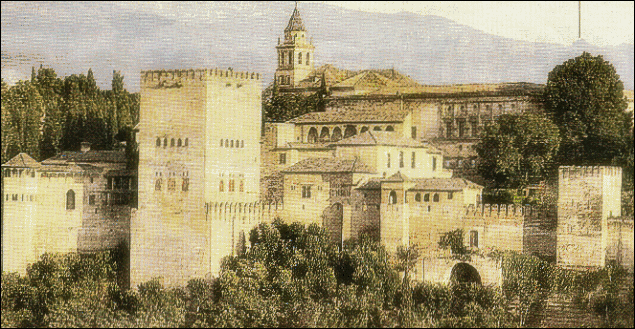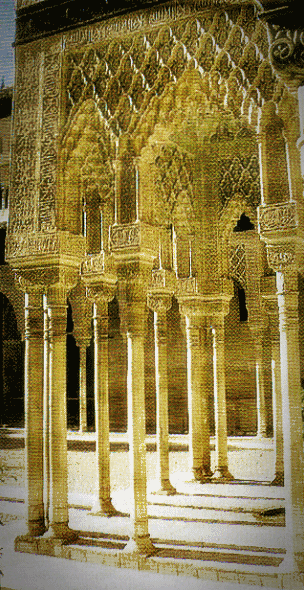Quest for knowledge
Dato' Dzulkifli Abd Razak
Article
New Sunday Times - 07/03/2005
 APEX OF ISLAM IN SPAIN: No place can serve as greater testament to the glories of Andalusia than the hills of Granada, especially that legendary hill known as the Alhambra. The fort, palace in gardens of Alhambra, whose beauty was legendary even then, were the heart and soul of the Moors.
APEX OF ISLAM IN SPAIN: No place can serve as greater testament to the glories of Andalusia than the hills of Granada, especially that legendary hill known as the Alhambra. The fort, palace in gardens of Alhambra, whose beauty was legendary even then, were the heart and soul of the Moors.
DURING the Abbasid rule, with the exception of the literary texts, Greek works were re-introduced as part of the remarkable new Arabic culture of learning, and later that of Andalusia.
According to Professor Maria Rosa Menocal of Yale University, in her book The Ornament in the World, it was in al-Andalus that the profoundly "Arabised" Jews rediscovered and reinvented Hebrew.
It was also in al-Andalus that the Christians embraced nearly every aspect of Arabic style — from intellectual style of philosophy to the architectural styles and game of chess — not only while living under Islamic domination but especially after wresting political control from them.
The word "Arabised" is used to acknowledge that the Andalusians did a great deal more than merely learn to speak the language.
This facilitated the development of a knowledge web in Andalusia, with Cordoba as the hub initially.
This is indeed fortunate because in 8th century Spain, the prevailing body of knowledge had become fossilized inside its antiquated environment, leading to the wholesale loss of intellectual traditions.
But it acquired a fresh life, metamorphosing into a vital young and rigorous Arabic universe.
Certainly, book collecting was one of the passions of the times. Both Abdul-Rahman and his son, Al-Hakam II (961-976), built huge libraries.
Al-Hakam II will be remembered for his patronage of literature and learning, since it is during his reign that the palace library became one of the greatest in the world.
The library had as many as 400,000 titles, from as far a field as Persia, with the catalogue alone filling 44 volumes.
Many of the works were lavishly decorated by the scribes, gilders, printers and binders.
There were also librarians' information on 600,000 volumes.
Menocal cited the historian and author of The Decline and Fall of the Roman Empire, Edward Gibbon, who describes the book worship of the Islamic polity he so admired in Cordoba, compared to the anti-book culture of medieval Europe.
INTRICATE: Pillars and carvings at the Alhambra,Granada. |
This is at a time when the largest library in Christian Europe probably held no more than 400 manuscripts, according to Menocal. Even centuries later, the largest libraries in monasteries and towns of Western Europe held anything form several dozen to 150 volumes. Only wealthy libraries like Durham had more than five hundred. On the contrary, in cities such as Baghdad, Damascus, Cairo, Cordoba, Shiraz and Bukhara, where the Islamic influence was strong, there were a series of libraries and private collections of 10,000 volumes or more in the 10th and 11th centuries. In 10th century Cordoba, for example, then the capital of Umaiyad Spain (929-1031), is the city said to be unrivalled in both the East and West for its wealth and civilisation. Andalusian scholars served as a major conduit bringing Greek philosophy, of which the Muslims had previously been the main custodians, to Western Europe |
It is during the 10th century too that al-Andalus produced a large number of excellent physicians, some of whom studied Greek medical works translated at the famous House of Wisdom, a storehouse of knowledge specifically built in Baghdad.
Cordoba had by then benefited from the vast translation and then passed it on to the rest of the Anglophone world. The citizens had been eager, even greedy, recipients, as the impressive Cordoban libraries.
Without doubt, in the 10th century, the intellectual superiority of the Andalusians with their Arabised culture of learning was recognised in Europe.
The rich and varied cultural and intellectual Arabised European universe in the 9th and 10th centuries provided the backdrop for the Umaiyad vision.
Cordoba, with its some 100,000 inhabitants, was not only the capital but also the most important city of the Caliphate, making it Europe's principal urban concentration during that period.
Soon Cordoba could boast of a population of some 500,000, compared to about 38,000 in a European city such as Paris.
According to the chronicles of the day, the city had 700 mosques, some 60,000 palaces and 70 libraries — one reportedly housing 500,000 manuscripts and employing a staff of researchers, illuminators and book binders.
By comparison, major libraries in western Europe scarcely reached a thousand.
Even into the 14th century, the library at the University of Paris only had about 2,000 books.
By 976, the library of Cordoba was said to have employed 500 librarians, scribes, physicians, historians, geographers and copyists.
The catalogue not only had swollen to 44 volumes, but arranged by subject, then order of acquisition.
Acquiring new materials was not difficult, as titles moved freely from Byzantium to Baghdad, Cairo to Cardoba, by way of Venetian and Arab shipping routes.
Cordoba's caliphal library was itself one of the 70 libraries in a city that apparently so adorned books that a report of the time indicated that there were 70 copyists in the book market who worked exclusively on copying the Quran.
Clearly, the web of knowledge in Cordoba in the form of libraries alone was already a significant benchmark of overall social (not just scholarly) well-being, since it represented a near-perfect crossroads of the material and the intellectual.
The libraries in turn were affiliated with a sprawling network of copyists, booksellers, paper makers arid colleges, churning out as many as 60,000 treatises, poems, polemics and compilations a year.
The head librarian at Cardoba was personally appointed to the mosque collection by al-Hakam, the then Caliph of Cordoba.
It is no wonder Andalusia is very much closely associated with the birth of a civilisation, perhaps not different from what is envisaged by the concept of Islam Hadhari.
